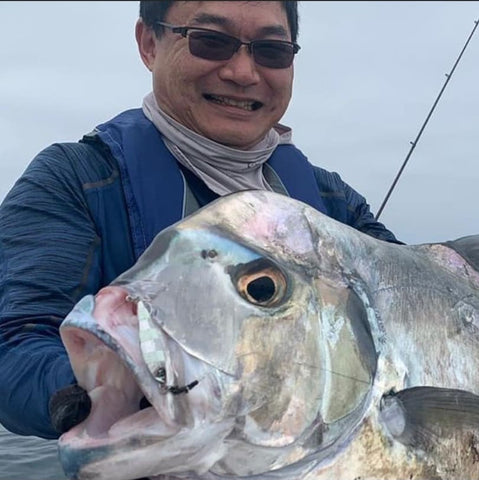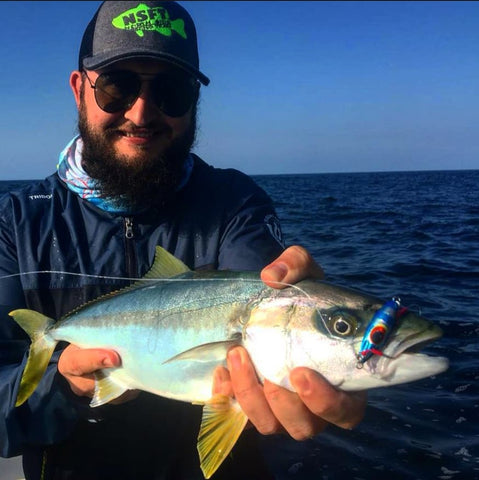This style of fishing with extremely small jigs has been practiced in Japan for a long time and it was created because of a need to search for small fish amid rocks and coastal areas, in order to be a light and fun fishing trip for a wide variety of species.

Claudio Muranaka and the African Pompano catched with Crazee Casjig
When we talk about a “jig” we already associate it with heavy metal lures and short rods for vertical fishing, commonly known as vertical jigging, but micro jigging is quite different in several aspects, and the most evident is the weight of the lures and the dimensions of the equipment. Originally in Japan, long rods, over 7 feet, very thin lines, PE 0.4 to PE 1, jigs between 1g to 12g, and shock leader between 10 and 16 lbs are used, all very small, as the target fish are also small and aloof. Examples of this Japanese equipment are the Seabass Varivas line, the Varivas leaders, Decoy DJ-92 assist and the Jigs Smith Wobblin, Maxel Dragonfly L, and Crazee Cazjig, all sold in Brazil by Everquest Sports and in USA by The Fisherman’s Hut.

Micro Jig Smith Wobblin



The micro jig Crazee Casjig
In Japan, this kind of fishing is done by walking along the rocks, beaches, and estuaries, in order to catch a large number of species, the majority of which are stone or passing like the valiant horse mackerel, a true show of sport when the fish is a little bigger. Most jigs are made of tungsten, a material that is denser than lead and allowing greater weight in a smaller size of the bait.
The Micro Jigging modality arrived in Brazil not long ago, learned by enthusiastic fishermen in search of the diversity of Japanese fishing styles, and has adapted very successfully in Brazilian waters. Here the modality has undergone some adaptations in its style, being widely used in onboard fisheries. In Brazil, we have great fishing pressure that makes the fish act more aloof and skittish. Also, the decrease in line thickness, shockleaders, and lures makes a difference in the capture of several species. Not only small but also fish of considerable sizes are being caught with this fishing technique.

Willian Ros using the Xesta Slowbee micro jig.
Another point that makes Micro Jigging a successful modality is the size of the jigs that are very similar to the size of food that predators are used to eating. As the saying goes: “less is more!” And it works! The smaller the bait, the bigger the fish!!

Big fish with micro jigs! (Smith)
When fishing in parcels, the micro jig is also launched to a considerable distance from the boat, allowed to reach the desired depth and is worked with touches of the tip of the rod, and then allowing the jig to sink a little. This movement is repeated until you need to launch again. While fishing next to rocks, or “fishing in the foam” as it is known, the jig is launched and worked with touches varying the movements, in this type of fishing the rods need not be so long; just 7 feet on average, like the Tailwalk Micro Gamer and Crazee Light Jigging.
Longer rods, between 7 and 9 feet, are used for fishing while landed on the rocks, for greater pitch distance and line protection, as the fisherman needs to keep the line as far away from the rocks as possible.
If you have not yet tried this modality thinking that you would only catch small fish, you are mistaken, because large trophies have already been captured with this style, in addition to the fact that great sportsmanship and technique are required to provide incredible moments. The sport fisherman needs to adapt to changing fishing needs as it is increasingly difficult to find fishy places in Brazil, so don't wait any longer! Try micro jigging and you will surely fall in love with this technique!

